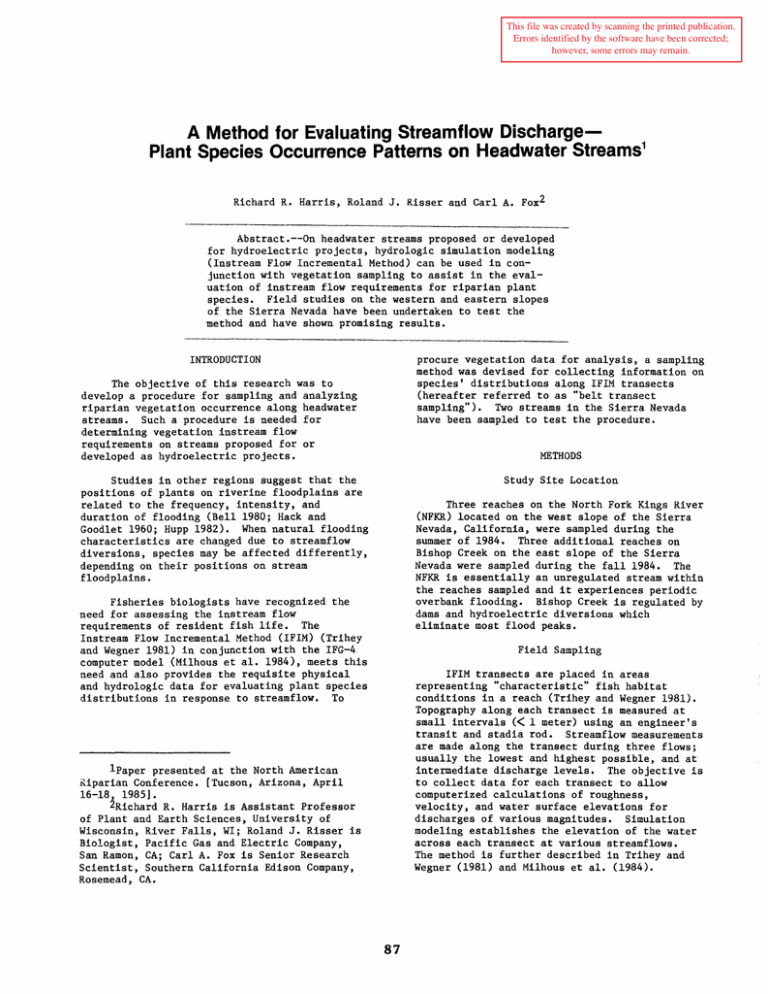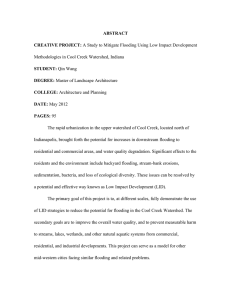A Method for Evaluating Streamflow ... Plant Species Occurrence Patterns on Headwater...
advertisement

This file was created by scanning the printed publication. Errors identified by the software have been corrected; however, some errors may remain. A Method for Evaluating Streamflow DischargePlant Species Occurrence Patterns on Headwater Streams1 Richard R. Harris, Roland J. Risser and Carl A. Fox 2 Abstract.--On headwater streams proposed or developed for hydroelectric projects, hydrologic simulation modeling (Instream Flow Incremental Method) can be used in conjunction with vegetation sampling to assist in the evaluation of instream flow requirements for riparian plant species. Field studies on the western and eastern slopes of the Sierra Nevada have been undertaken to test the method and have shown promising results. INTRODUCTION procure vegetation data for analysis, a sampling method was devised for collecting information on species' distributions along IFIM transects (hereafter referred to as "belt transect sampling"). Two streams in the Sierra Nevada have been sampled to test the procedure. The objective of this research was to develop a procedure for sampling and analyzing riparian vegetation occurrence along headwater streams. Such a procedure is needed for determining vegetation instream flow requirements on streams proposed for or developed as hydroelectric projects. METHODS Studies in other regions suggest that the positions of plants on riverine floodplains are related to the frequency, intensity, and duration of flooding (Bell 1980; Hack and Goodlet 1960; Hupp 1982). When natural flooding characteristics are changed due to streamflow diversions, species may be affected differently, depending on their positions on stream floodplains. Study Site Location Three reaches on the North Fork Kings River (NFKR) located on the west slope of the Sierra Nevada, California, were sampled during the summer of 1984. Three additional reaches on Bishop Creek on the east slope of the Sierra Nevada were sampled during the fall 1984. The NFKR is essentially an unregulated stream within the reaches sampled and it experiences periodic overbank flooding. Bishop Creek is regulated by dams and hydroelectric diversions which eliminate most flood peaks. Fisheries biologists have recognized the need for assessing the instream flow requirements of resident fish life. The Instream Flow Incremental Method (IFIM) (Trihey and Wegner 1981) in conjunction with the IFG-4. computer model (Mi1hous et a1. 1984), meets this need and also provides the requisite physical and hydrologic data for evaluating plant species distributions in response to streamflow. To Field Sampling IFIM transects are placed in areas representing "characteristic" fish habitat conditions in a reach (Trihey and Wegner 1981). Topography along each transect is measured at small intervals « 1 meter) using an engineer's transit and stadia rod. Streamflow measurements are made along the transect during three flows; usually the lowest and highest possible, and at intermediate discharge levels. The objective is to collect data for each transect to allow computerized calculations of roughness, velocity, and water surface elevations for discharges of various magnitudes. Simulation modeling establishes the elevation of the water across each transect at various streamf10ws. The method is further described in Trihey and Wegner (1981) and Mi1hous et a1. (1984). 1Paper presented at the North American Riparian Conference. [Tucson, Arizona, April 16-18 1985]. 2Richard R. Harris is Assistant Professor of Plant and Earth Sciences, University of Wisconsin, River Falls, WI; Roland J. Risser is Biologist, Pacific Gas and Electric Company, San Ramon, CA; Carl A. Fox is Senior Research Scientist, Southern California Edison Company, Rosemead, CA. 87 Belt transect sampling over established IFIM transects was performed after floodplain topography had been surveyed. The rooted location of all plants on the floodplain was recorded within a belt 3 meters wide centered on the IFIM transect line. Plant positions were recorded as the cumulative distance from the starting point of the transect to the nearest 0.1 meter. These data established the position of each plant with respect to distance from the stream, elevation above the stream, and simulated discharge level. On NFKR, only data on plant positions were collected. The sampling procedure was modified at Bishop Creek to collect auxiliary data on light (percent canopy closure over plants), rooting substrate, channel geometry and groundwater influence. 2. Species flooded at relatively low discharge, frequently and/or for a long duration. Juncus nevadensis, Care x spp. and HeIeDIUm Bige10vii represented this condition. 3. Species flooded at intermediate discharges or those whose bimodal distribution causes them to be flooded at both extremes. Six of the 12 species analyzed represented this condition. The work at NFKR indicated that each of three different flooding environments had a characteristic complement of plant species. Within these environments, the effects of other environmental conditions on plant occurrence could not be evaluated because relevant data were not available at time of the analysis. Analysis Procedures To analyze species' distributions across all transects, the position of each plant was calculated as the proportional horizontal distance from the thalweg (lowest point of the stream channel bottom) to the end of the ha1ftransect on which the plant occurs. Using mUltiple analysis of variance, each species distribution above and horizontally away from the thalweg was compared to that of all other species. The frequency distribution of each species by simulated discharge class was also evaluated. Bishop Creek A total of 60 IFIM transects were sampled on Bishop Creek. Analysis of plant speciesdischarge relationships indicated no differentiation of species by simulated discharge class. This may be a consequence of the fact that the modeled discharges were all within the channel banks and that plants dependent on streamflow were aggregated near the banks. Plants rooted at greater distances could not be directly affected by streamflow because no overbank discharges were modeled and none appeared to occur on this controlled stream. Ko1mogrov-Smirnov two sample tests (Soka1 and Rohlf 1981) were used for the latter analysis under the null hypothesis of no significant differences between the species. Differences were considered significant at p 0.01. The procedure for statistical analysis of environmental data from Bishop Creek (other than streamflow) has not yet been defined. Interested readers should contact the senior author for further information. These results led to an exploratory analysis of the data to determine the effects of other environmental factors on species' occurrence patterns. Although this analysis has not been completed, preliminary results indicate that some species were associated with specific environmental conditions. For example, Rosa woodsii and Populus tremu10ides appear to De associated with incised channels. Artemesia tridentata, a dry land species, did not occur on transects where groundwater influence was evident. Other species appeared to be associated with specific light or substrate conditions. RESULTS NFKR. Vegetation data were collected along 22 IFIM transects at NFKR. Occurrence patterns of the 12 most frequently encountered riparian species were analyzed. Statistical analysis confirmed three types of riparian plant distributions in relation to stream discharge on NFKR: 1. To fully evaluate species' responses to environmental conditions at Bishop Creek, a multivariate analysis will be undertaken in the next phase of this research. For the present, it is tentatively concluded that within a specific zone of flooding effects or on controlled streams, plant species may differentiate along environmental gradients other than those associated with flooding. Species flooded infrequently, only at high discharge, and with a short duration. Rhododendron occidenta13 , Fraxinus 1atifo1ia and Alnus rhombifo1ia represented this condition. DISCUSSION Alterations in instream flow often result from hydroelectric development. The effects of these alterations on riparian vegetation may be manifested in terms of changes in the distributions and characteristics of plant 3 Nomenclature follows Munz (1975) 88 species on the floodplain. A study of existing diversions on headwater streams of the western Sierra Nevada disclosed two different general responses to diversion (Harris and Risser in preparation). Some streams were observed to have increased riparian species cover, apparently due to reduced destructive effects of flooding. Other streams were observed to have decreased riparian species cover, presumably due to induced soil moisture stress. Utilization of IFIM data allows an analysis of the directional response of plant species which may improve our understanding of overall vegetation effects. For impact assessment on streams proposed for diversion, two levels of vegetation data are required: 1) General habitat conditions need to be described (e.g. vegetation characteristics, subtrate, gradient). This type of data may be obtained through extensive, rapid survey techniques. 2) Plant distribution vis-a-vis topography and discharge should be analyzed. Belt transect sampling is suitable for collection of this type of information. An integrated instream resource inventory method would include both techniques. Rapid survey techniques could be used to generally characterize the riparian vegetation on a stream. Only vegetation data would be collected. Collection of topographic data could be reduced to classification of floodplain cross sections to allow later correlation with IFIM modeling results. The distribution of riparian plants can be interpreted as species' responses to ecological conditions within the floodplain. If it is assumed that flooding is the dominant controlling variable on unregulated streams, species most tolerant to flooding will be found in relatively high abundance in lower discharge classes. Areas closer to the thalweg are often too disturbed by flooding for most plants to survive in abundance (Menges and Waller in press; Harris 1985). Since lower discharges occur more frequently, these plants are flooded more often and for a relatively greater proportion of the year. These species may be adversely affected if streamflow is reduced in such a way that they are no longer flooded according to existing conditions. Their abundance may decline as a result of moisture stress, reduced reproductive potential, or invasion by more competitive species. Belt transects should be situated to ensure sampling of the range of vegetation conditions found on streams. If properly located, the belt transects are adequate for evaluating occurrence patterns, density, and species diversity. The results can be used to predict impacts for the streamside vegetation as a whole. ACKNOWLEDGMENTS Dr. Robert F. Holland and Virginia Dains collected the field data used for this study. David Hanson, EA Engineering, Science, and Technology, Inc. and Thomas Lambert, Pacific Gas and Electric Company (PG&E) assisted in the interpretation of IFIM hydrologic modeling. Phillip Dunn, Jones & Stokes Associates, provided information on IFIM field techniques. Jordan Lang and JoAnne Sorenson (Jones & Stokes Associates) and Michael Fry (PG&E) provided helpful comments on drafts of the manuscript. Some species are most frequently found in locations where flooding occurs only at higher discharges. These species appear the least tolerant of flooding. If streamflow is reduced, these species may increase in abundance by occupying formerly unfavorable habitats. Species which have indistinct distributions in relation to discharge may be relatively insensitive, or may have equal sensitivity to flooding effects. Intermediate locations where these plants are located are subject to greater variability in both frequency and duration of flooding then either adjacent zone. Within the intermediate zone, rising and falling water levels result in constantly changing conditions for plant establishment. This may help explain the fact that intermediate locations have a greater number of plant species. Annually, as flooding flows occur, conditions within a given stream reach may change, creating optimal conditions for a different complement of species. This research was financially supported by Pacific Gas and Electric Company and Southern California Edison Company. LITERATURE CITED Bell, D. T. 1980. Gradient trends in the streamside forest of central Illinois. Bulletin Torrey Botanical Club 107:172-180. Hack, J. T., and J. C. Goodlet. 1960. Geomorphology and forest ecology of a mountain region in the central Appalachians. 66 p. U.S. Geological Survey Professional Paper 347. The effects of light, substrate, and root stratification may affect these generalizations. On controlled streams or within a specific zone of flooding effects, species may differentiate on the basis of light, substrate or other factors. Interactions among factors and compensatory mechanisms may exist and may affect responses of species to increases or decreases in streamflow. In future testing of this method these relationships will be studied more fully. Harris, R. R. 1985. Relationships between fluvial geomorphology and vegetation on Cottonwood Creek, Tehama and Shasta Counties, California. Ph.D Dissertation. 329 p. Univeristy of California, Berkeley, CA. 89 Information Paper 11. U.S. Fish and Wildlife Service. FWS/OBS-8l/43 (Revised). Harris, R. R. and R. J. Risser. In preparation. Characteristics of riparian vegetation at existing and proposed hydroelectric diversions in the western Sierra Nevada, California. Munz, P. A., and D. D. Keck. 1975. A California flora and supplement. University of California Press, Berkeley, CA. Hupp, C. F. 1982. Stream-grade variation and riparian forest ecology along Passage Creek, Virginia. Bulletin Torrey Botanical Club 109:488-499. Sokal, R. R., and F. J. Rohlf. 1981. Biometry. Second Edition. 776 p. W. H. Freeman and Company, New York, N.Y. Menges, E. S. and D. M. Waller. In press. Plant strategies in relation to elevation and light in floodplain herbs. American Naturalist. Trihey, E. W., D. L. Wegner. 1981. Field data collection procedures for use with the physical habitat simulation system of the Instream Flow Group. U.S. Fish and Wildlife Service, Cooperative Instream Flow Service Group. 151 p. Fort Collins, CO Milhous, R. T., D. L. Wegner, and T. Waddle. 1984. Users guide to the physical habitat simulation system. Instream Flow 90








